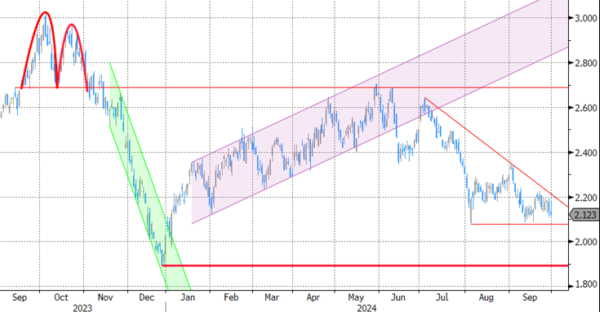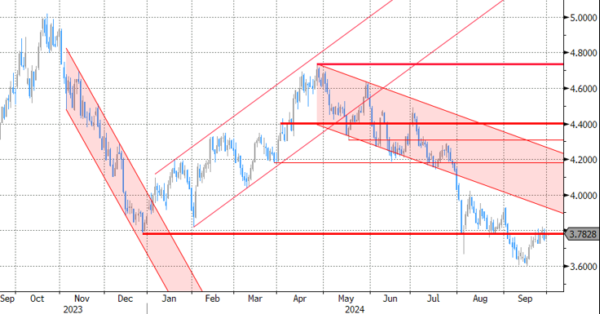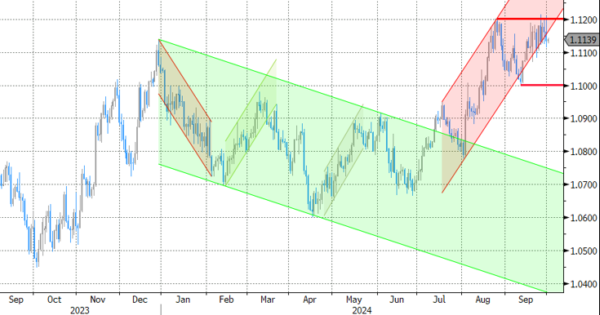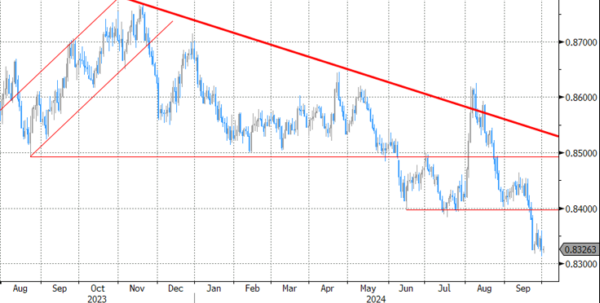Markets
Fed Chair Powell implicitly defended the base case as set out in the updated September dot plot. This year’s median suggested an additional 50 bps of cumulative Fed rate cuts, being 25 bps in November and 25 bps in December with the Fed taking its time after the bumper liftoff. Powell indicated that the economy is in a solid shape. If it performs as expected that would mean two more (25 bps) cuts this year. The committee isn’t in a hurry to cut rates quickly. With two economic updates and one inflation print between now and the next, November 7, policy meeting, Powell nevertheless kept his options open. “Ultimately we will be guided by the incoming data. And if the economy slows more than we expect, then we can cut faster. If it slows less than we expect, we can cut slower.” The market implied probability of a 50 bps November step dropped from 50% to 37% in the wake of the comments (EUR/USD bumped again into 1.12 resistance), but we expect more and wilder swings to come. Starting this week, but likely lasting throughout the month as we fear that the debate won’t be settled any time soon. We stick to our 50 bps rate cut call. The September Chicago PMI kicked off this week’s flurry of eco data with a near consensus print (46.6 from 46.1 vs 46 expected). Things become more interesting today with JOLTS job openings and the manufacturing ISM. The first is on a steady decline since hitting peak levels in Q1 2022. A continuation could bring JOLTS for the first time below the pre-pandemic peak (7.6mn) and raise more questions about the shape of the labour market. The second is mired in recession territory since Q4 2022 with no signs of revival expected. The combination of the both can immediately contrast with Powell’s baseline scenario as set out yesterday. The start of the first East and Gulf port strikes since 1977 as dockworkers contracts’ expired without new deal are a wildcard for trading. The longer the shutdown takes, the bigger the negative impact on the economy but also the higher the impact on prices. Port employers raised their offer from a 40% to 50% increase over six years, but unions stand by their demands for a 77% pay bump as condition to restart negotiations.
Today’s EMU September CPI print is especially interesting for core CPI and services CPI metrics as ECB President Lagarde yesterday suggested that she also sees a downward trend (in core) with services inflation beginning to abate. She will take increased disinflation confidence into stride at the October policy meeting while the suppressed level of some survey indicators suggests that the recovery is facing headwinds. Both boost chances that the ECB could pull the trigger in October. We keep a close eye on speeches by individual ECB members as well to see whether everybody’s on the same line as the ECB president.
News & Views
Japan’s Tankan survey signaled a strong business sentiment in Q3, especially in services. The non-manufacturing gauge polling for current conditions unexpectedly rose to 34, matching the March top which was the highest in 33 years. Its outlook gauge grinded higher to a 33-year high as well, though came in a bit below estimates (28 vs 30, from 27). Manufacturing stabilized at the Q2 levels of 13 (current conditions) and 14 (outlook), defying expectations for a slight decline to 12 of the both. Industries across the spectrum plan to increase investments by 10.6% in the fiscal year ending March 2025. That’s slightly less than the 11.1% in Q2 and below a 11.9% consensus estimate. Businesses expect CPI inflation at 2.2% in five years’ time, the same as in the previous edition and above the Bank of Japan’s 2% target. The combination with solid business sentiment effectively greenlights further monetary policy normalization. Another rate hike isn’t priced in by markets before January of next year though. JPY loses some ground today (USD/JPY 144.3) but that had to do with the release of relatively dovish BoJ September Minutes.
Australian retail sales rose 0.7% in August, picking up from a near-flat 0.1% in July. Head of business statistics at the Australian Bureau of Statistics Ewing attributed the solid rise to warmer-than-usual weather. Retail turnover rose in most industries with department stores in the non-food segment showing the largest rise (+1.6%), followed by clothing, footwear and personal accessory retailing (1.5%) and other retailing (1.3%). The warmer end to the winter months also boosted dining out at cafes and restaurants as well as alcohol consumption at home. The Aussie dollar gains some territory this morning in the wake of the release. AUD/USD is testing recent highs around 0.693.
Graphs
GE 10y yield
The ECB cut policy rates by 25 bps in June and in September. Stubborn inflation (core, services) make follow-up moves less evident. We expect the central bank to stick with the quarterly reduction pace. Disappointing US and unconvincing-to-outright-weak EMU activity data dragged the long end of the curve down. The move accelerated during the early August market meltdown.
US 10y yield
The Fed kicked off its easing cycle with a 50 bps move. It is headed towards a neutral stance now that inflation and employment risks are in balance. Conservative SEP unemployment forecasts risk being caught up by reality and with it the dot plot (50 bps more cuts in 2024). We hold our call for two more 50 bps cuts this year. Pressure on the front of the curve and weakening eco data keeps the long end in the defensive for now as well.
EUR/USD
EUR/USD moved above the 1.09 resistance area as the dollar lost interest rate support at stealth pace. US recession risks and bets on fast and large rate cuts trumped traditional safe haven flows into USD. An ailing euro(pean economy) only briefly offset some of the general USD weakness. EUR/USD’s dollar-driven ascent is nearing resistance around 1.12 again.
EUR/GBP
The BoE delivered a hawkish cut in August. Policy restrictiveness will be further unwound gradually on a pace determined by a broad range of data. The strategy similar to the ECB’s balances out EUR/GBP in a monetary perspective. But the economic picture is increasingly diverging to the benefit of sterling. EUR/GBP succumbed to horrible European September PMI’s. Support at 0.84 broke and brings the 2022 low (0.8203) on the radar.

















